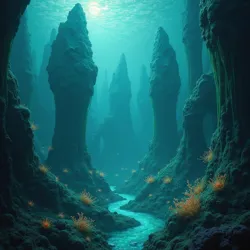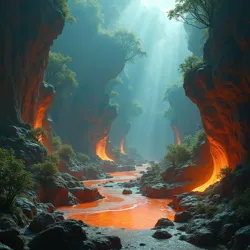Lexicanum Mundi

A representation of a comprehensive repository of knowledge covering history, science, culture, geography, and diverse lifeforms across cosmic realms.
Knowledge Repository
Document diverse realities
History, science, culture, geography
Verifiable information
Accessible to all
Non-profit
Free use/distribution (with attribution)
Volunteers and community
| City Cluster Name | Estimated Founding Epoch | Dominant Weaver Subspecies | Notable Architectural Feature |
|---|---|---|---|
| Ancelian Prime | ~8,500 cycles ago | Pulsing Azure Weaver | Grand Central Spire |
| Ky'tarr's Cradle | ~6,100 cycles ago | Whispering Pearl Weaver | Hanging Gardens of Light |
| Z'har's Descent | ~4,900 cycles ago | Resilient Amber Weaver | Reinforced Current Walls |
| Fathoms' Bloom | ~3,200 cycles ago | Bioluminescent Crimson Weaver | Network of Nutrient Veins |
The Lexicanum Mundi serves as a comprehensive repository of knowledge concerning the myriad facets of existence across the known spheres and their interactions. It aims to document history, science, culture, geography, and the diverse lifeforms that populate these realms, providing a neutral and detailed account accessible to all seekers of understanding. This collaborative project is built upon the principle of verifiable information, drawing from historical records, observational data, and scholarly analysis.
Featured Article
The Symbiosis of the Glyphic Weavers and the Sunken Cities
 Intricate crystalline structures secreted by sessile organisms, cultivated and shaped by sapient deep-dwellers to form vast, living underwater cities.
Intricate crystalline structures secreted by sessile organisms, cultivated and shaped by sapient deep-dwellers to form vast, living underwater cities.The intricate relationship between the sessile, bioluminescent organisms known as Glyphic Weavers and the mobile, sapient inhabitants of the Sunken Cities represents one of the most profound examples of Symbiosis recorded in the Hydrospheres of several major planetary bodies, particularly prominent on the world designated Caelum Tertius. This unique interdependency forms the biological and societal bedrock for both species, dictating their life cycles, architectural practices, and cultural expressions. The Glyphic Weavers, taking root on stable substrata within the deep currents, secrete complex biochemical compounds that solidify into intricate, crystalline structures. These structures, often spanning hundreds of meters, serve as both habitat and nutrient source for the Weavers themselves, filtering particulate matter from the surrounding water column.
The peoples of the Sunken Cities, often referred to in ancient texts as the K'tharr or "Deep Dwellers," are a highly evolved species adapted to high-pressure, low-light environments. Their traditional settlements are not built in the conventional sense but are rather guided growths utilizing the metabolic byproducts of mature Glyphic Weavers. The K'tharr cultivate and shape the crystalline secretions of the Weavers, directing their growth patterns to form enclosed spaces, conduits for nutrient flow, and anchor points against powerful currents. This process, often referred to as "Bio-Sculpting," is a central element of their Urban planning and involves generations of careful tending and understanding of Weaver physiology. The relationship is not merely structural; the Weavers emit specific light patterns and low-frequency sonic pulses that are interpreted by the K'tharr as a form of communication, conveying information about nutrient availability, approaching currents, and even communal well-being.
Biological and Architectural Interdependence
The biological cycle of the Glyphic Weaver is intrinsically linked to the migratory patterns of the Sunken Cities' populations. Weavers begin life as free-floating spores, seeking out stable surfaces. Once anchored, their growth rate is slow, taking decades or even centuries to reach maturity and begin significant crystalline secretion. The K'tharr migrations are often timed to coincide with the maturation cycles of Weaver colonies, establishing new city-clusters around promising growth sites. The crystalline structures produced by the Weavers exhibit remarkable strength and resilience, capable of withstanding immense hydrostatic pressures and the erosive forces of deep-sea currents. These formations are not static; they continue to grow and change throughout the Weaver's lifespan, requiring constant monitoring and occasional shaping by the K'tharr Bio-Sculptors.
From an architectural perspective, the Sunken Cities are living structures. The crystalline matrix provides the primary structural support, forming walls, ceilings, and internal divisions. The K'tharr integrate their own organic and technological systems within this framework. Bioluminescent organisms are cultivated to provide light, while specialized conduits, also bio-sculpted from Weaver secretions, transport oxygenated water and nutrients throughout the city. Recycling systems process waste, often feeding it back into the Weaver's nutrient uptake, creating a closed-loop ecosystem. The scale of these cities can be vast, housing hundreds of thousands or even millions of K'tharr, with sprawling crystalline spires and cavernous internal spaces. The oldest known Sunken Cities are estimated to be thousands of years old, representing continuous habitation and bio-sculpting across countless K'tharr generations.
Cultural and Societal Implications
The symbiosis has deeply permeated the cultural and societal structures of the K'tharr. Their social hierarchy often reflects roles related to the care and cultivation of the Glyphic Weavers. Bio-Sculptors are held in high esteem, possessing encyclopedic knowledge of Weaver biology and growth patterns. The interpretation of Weaver light and sound patterns is the domain of the "Chorus Listeners," a priestly or scholarly class responsible for understanding the "voice" of the city. Even their artistic expressions, from intricate carvings on the crystalline surfaces to sonic compositions mimicking Weaver pulses, are centered around this core relationship.
The K'tharr possess a rich oral tradition, preserving the history of their migrations and the founding of new cities. One oft-quoted passage from the Canticles of the Deep, a foundational epic poem, describes the first encounter:
"And the Deep Dwellers, adrift in the hungry dark, saw the first glimmer. Not sun, not star, but the soft pulse of the Weaver, a promise whispered in light. They reached out, not with tools of metal or stone, but with patient hands and knowing hearts, and from the light, a home began to grow."
This passage highlights the foundational nature of the Weaver relationship in their collective identity. The K'tharr calendar is often marked by the cycles of Weaver maturation and the subsequent city migrations. Their legal systems include provisions for the protection and sustainable harvesting of Weaver secretions, recognizing the organism not merely as a resource but as a co-inhabitant. Diplomatic interactions with other species, particularly those from the surface or shallow seas, are often complicated by the K'tharr's reliance on a living, non-mobile environment, making traditional concepts of borders and territories difficult to apply.
The study of the Glyphic Weaver-Sunken City symbiosis offers valuable insights into extremophile life, bio-engineering, and complex interspecies relationships. Research continues into the specific biochemical pathways involved in crystalline secretion and the neurological structures in the K'tharr that allow for interpretation of Weaver communication. Understanding this unique partnership is considered crucial for any future interactions with deep-sea civilizations and for advancing our own knowledge of biological systems under extreme conditions.
In the News
Recent reports indicate significant diplomatic progress in the ongoing negotiations regarding resource distribution in the Orbital Ring Systems surrounding Jovian planets. The Council of Nine Shores, representing the primary stakeholders from the inner sphere worlds, has reportedly reached a preliminary agreement with the Outer Belt Consortium on transit rights and extraction quotas for Rare-earth elements. This breakthrough follows months of tense discussions and minor skirmishes involving automated mining drones. The agreement, if ratified, is expected to stabilize the market for several key industrial materials and potentially open new avenues for collaborative resource management in the chaotic orbital environments.
 Diverse extremophile flora and fauna thriving in superheated, mineral-rich waters erupting from a planetary crust, illustrating a novel life environment.
Diverse extremophile flora and fauna thriving in superheated, mineral-rich waters erupting from a planetary crust, illustrating a novel life environment.Simultaneously, a major scientific expedition to the newly charted Ancelian Vents in the southern hemisphere of world Y has confirmed the existence of previously theoretical chemosynthetic ecosystems. Researchers from the Stellaris University have documented several novel species of extremophile flora and fauna thriving in the superheated, mineral-rich waters erupting from the planet's crust. The discovery of complex multicellular life forms in this environment challenges existing models of planetary habitability and offers tantalizing clues about the potential for life in similar conditions throughout the galaxy. Further analysis of the genetic and biochemical makeup of these organisms is underway, with potential implications for bio-engineering and astrobiology.
On the cultural front, the quadrennial Festival of the First Bloom commenced this cycle in the aerial cities of the Flying Archipelago on world Z. This vibrant celebration marks the synchronous blooming of the Sky-Gardens, massive cultivated ecosystems anchored to the floating landmasses. The festival features elaborate parades, artistic performances utilizing light and sound, and traditional aerial races. This year's festival is particularly significant as it includes delegations from the ground-dwelling Stone-Kin communities, marking a renewed effort to bridge the historical divide between the two distinct cultures of the planet. The opening ceremony included a symbolic exchange of 'seed-gifts', representing mutual growth and future cooperation.
Did You Know...
- ...that the Atmosphere of world Alpha Centauri III contains trace amounts of naturally occurring Superfluid helium-3, creating unique atmospheric phenomena like "current ghosts" and "pressure echoes"? This property has led to the development of specialized atmospheric navigation techniques unique to this planet.
- ...that the Great Barrier Library of Xylos, an archive carved into the side of a colossal crystal mountain, houses over ten million unique Data crystals containing the collected knowledge and history of the Xylosian civilization? The library's construction is said to have taken three thousand years.
- ...that certain species of deep-sea Fungus on world Delta Eridani IV exhibit a form of collective consciousness, communicating through slow-wave electrical pulses that travel through vast underground mycelial networks? Researchers are studying this phenomenon for potential applications in distributed computing.
- ...that the traditional currency of the desert nomads of world Beta Hydri VI is not metal or data, but intricately woven 'sand-silk' tapestries, with the value determined by the complexity of the weave and the rarity of the pigments used? This practice dates back to before the Great Drying period.
- ...that the Whispering Reefs on world Gamma Leporis V are not biological in origin but are formed by the slow accumulation of Sentient mineral formations that communicate through high-frequency vibrations? These formations react negatively to loud noises, causing local seismic disturbances.
On This Day...
23 Mirkos, Cycle 897: The Treaty of the Azure Gulf was formally signed, ending the protracted conflict between the coastal city-states of the Azure Federation and the nomadic seafaring clans of the Sunstone Archipelago. The treaty established fishing quotas, maritime borders, and mechanisms for dispute resolution, bringing a fragile peace to the contested waters.
12 Ophal, Cycle 1015: The first successful long-range teleportation of a non-sentient object was achieved by researchers at the Obsidian Spire Institute. A small mineral sample was instantaneously transported across a distance of 500 kilometers, marking a significant milestone in theoretical Teleportation research and opening new possibilities for interstellar travel and communication.
37 Siltos, Cycle 1204: The Chronicle of the Deep Currents, a monumental historical work detailing the movements and interactions of the Sunken Cities over millennia, was completed by the K'tharr scholar Z'har al-Ky'tarr. The Chronicle, inscribed onto bio-luminescent crystalline scrolls, remains a primary source for understanding the history and culture of the deep-dwelling civilizations.
05 Ignis, Cycle 1552: The volcanic eruption of Mount Pyralis on world Epsilon Indi II reached its peak, causing widespread destruction but also creating vast new fertile ash plains in the following years. The event is commemorated annually in the region as the "Day of Renewal," marking both the tragedy and the subsequent regeneration of the landscape.
29 Zephyr, Cycle 1888: The first contact protocol was successfully initiated between the human exploratory vessel Stardust Drifter and the silicon-based lifeforms of the Ring Nebula's dust clouds. Communication was established through modulated gravitational waves, representing a triumph of xenolinguistics and interspecies understanding.
Picture of the Day
A panoramic view capturing the shimmering, ephemeral architecture of a Sky-Garden city on world Z, suspended against a backdrop of swirling, multi-hued gas currents. Delicate, bioluminescent flora cascades from the city's lower tiers, creating glowing waterfalls of light that illuminate the perpetual twilight below. Numerous small, winged craft, resembling oversized insects, navigate the intricate network of aerial pathways connecting different parts of the city. In the distance, other floating islands, each with its own unique silhouette of cultivated structures, drift slowly through the atmosphere. The scene is a testament to the ingenuity and adaptability of the aerial inhabitants, showcasing their profound connection to their living environment.
From the Archives
Highlighting a significant event from the historical record, the archives feature documentation concerning the "Great Filter Event" of Cycle 782. This period saw a sudden and catastrophic collapse of several advanced civilizations across disparate star systems, seemingly unrelated in their technology or biology. Theories range from cosmic environmental shifts and unidentified energy phenomena to internal societal failures amplified by unforeseen factors. While no single cause has been definitively identified, the study of this event remains a crucial area of research, informing contemporary strategies for long-term civilizational resilience and inter-system cooperation. Archived documents include salvaged data logs, historical analyses, and philosophical treatises grappling with the implications of this widespread collapse.
Today's Featured List
Today's featured compilation details the "Principal Trade Routes of the Inner Spheres," documenting the established corridors for interstellar commerce, the primary goods exchanged, and the major trading hubs and waystations located along these paths. The list outlines routes such as the Obsidian Trail, known for its transport of rare minerals and heavy machinery, and the Silk-Thread Passage, vital for the movement of luxury goods, biological samples, and informational packets. It includes information on the dominant species involved in trade along each route, the types of vessels commonly used, and historical data on the volume and value of goods transported over various cycles. The complexities of navigating inter-jurisdictional space and managing logistical challenges across vast distances are also touched upon within the compilation's detailed entries.
Community Portal
The Community Portal serves as the central hub for contributors and users of the Lexicanum Mundi. Here, editors can find guidelines for article creation and editing, participate in discussions regarding content standards and policies, and propose new topics for inclusion. The portal also provides resources for new editors, including tutorials on markdown formatting and citation practices. Users are encouraged to report errors, suggest improvements, and engage in collaborative efforts to expand and refine the knowledge base. The community is dedicated to maintaining a neutral point of view and ensuring the accuracy and comprehensiveness of all entries. Discussion forums are available for specific topics, project coordination, and general inquiries about the wiki's operation.
Recent Changes
The Recent Changes feed provides a real-time log of edits and new page creations across the Lexicanum Mundi. This allows editors to monitor activity, review contributions for accuracy and adherence to guidelines, and identify areas requiring attention. Each entry in the feed typically includes the page name, the type of change (edit, new page, deletion), the user responsible for the change, and a brief summary of the edit. Patrollers utilize this feed to detect and revert vandalism or inaccurate information quickly. The feed is filterable by namespace, user, or specific keywords, enabling targeted monitoring of areas of interest. High levels of activity are often observed in sections covering rapidly evolving scientific discoveries or ongoing political events.
About This Wiki
The Lexicanum Mundi project was initiated with the goal of creating a freely accessible, comprehensive, and reliable source of information about the diverse realities and histories that exist across the known cosmos. It operates on a Non-profit organization model, supported by contributions from individuals and academic institutions. The content is licensed under terms that permit free use and distribution, provided attribution is given. The wiki's infrastructure is maintained by a team of dedicated volunteers, and its content is generated and curated by a global community of editors, scholars, and enthusiasts. The scope of the Lexicanum Mundi is continuously expanding as new discoveries are made, historical records are unearthed, and our understanding of the universe deepens. It strives to be a living document, reflecting the ever-growing body of knowledge.